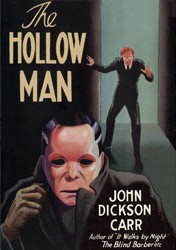The Hollow Man (Carr novel)
 1st UK edition | |
| Author | John Dickson Carr |
|---|---|
| Language | English |
| Series | Gideon Fell |
| Genre | Mystery, Detective, Novel |
| Publisher | Hamish Hamilton (UK) & Harper (USA) |
Publication date | 1935 |
| Publication place | United Kingdom |
| Media type | Print (hardback & paperback) |
| Preceded by | Death-Watch (1935) |
| Followed by | The Arabian Nights Murder (1936) |
The Hollow Man is a famous locked room mystery novel by the American writer John Dickson Carr (1906–1977), published in 1935. It was published in the US under the title The Three Coffins, and in 1981 was selected as the best locked room mystery of all time by a panel of 17 mystery authors and reviewers.[1]
Plot summary
This article is missing information about Error: you must specify what information is missing.. (May 2011) |
One wintry night in London, two murders are committed in quick succession. In both cases, the murderer has seemingly vanished into thin air.
In the first case, he has disappeared from Professor Grimaud's study after shooting the professor—without leaving a trace, with the only door to the room locked from the inside, and with people present in the hall outside the room. Both the ground below the window and the roof above it are covered with unbroken snow.
In the second case, a man walking in the middle of a deserted cul-de-sac at about the same time is evidently shot at close range, with the same revolver that killed Grimaud and only minutes afterward, but there is no one else near the man; this is witnessed from some distance by three passersby—two tourists and a police constable—who happen to be walking on the pavement. It takes Dr Gideon Fell, scholar and "a pompous pain in the neck," who keeps hinting at the solution without giving it away, some 200 pages to finally condescend and minutely reconstruct the two crimes and thus solve the mystery.
Literary significance and criticism
This novel is especially famous for the "locked room lecture", Dr. Fell's explanation of the various ways a person can commit a near-perfect murder in an apparently locked-room or otherwise impossible-crime situation. Thus, it became one kind of a "textbook for crime writers." In the course of his discourse, Dr. Fell states, off-handedly, that he and his listeners are, of course, characters in a book.
Trivia
The hypothetical third brother of Grimaud and Fley is nicknamed Brother Henri. This is a reference to a skit by J. M. Barrie, in which a conversation saddled him with a brother named Henry who did not exist; rather than correct the error, the timid Mr. Barrie was burdened with this error afterwards. The incident was also referred to by G. K. Chesterton, the model for Dr. Fell.
References
External links
- wiki collection of quotations from The Hollow Man
